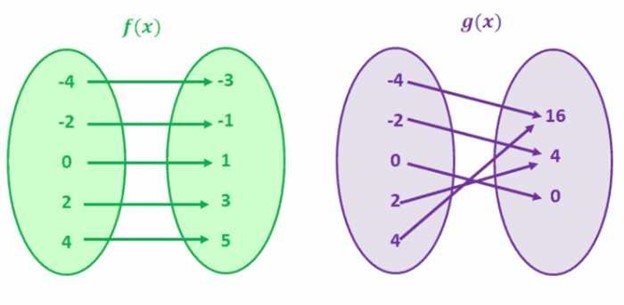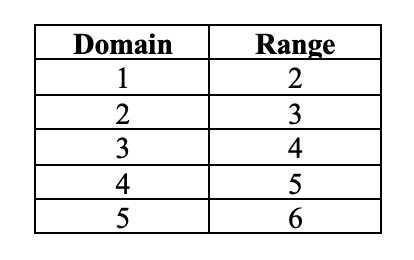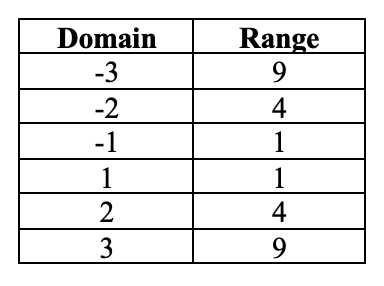One to One Functions - Graph, Examples | Horizontal Line Test
What is a One to One Function?
A one-to-one function is a mathematical function in which each input corresponds to just one output. That is to say, for every x, there is only one y and vice versa. This signifies that the graph of a one-to-one function will never intersect.
The input value in a one-to-one function is the domain of the function, and the output value is the range of the function.
Let's look at the pictures below:

For f(x), any value in the left circle correlates to a unique value in the right circle. In the same manner, each value on the right corresponds to a unique value on the left side. In mathematical jargon, this means that every domain holds a unique range, and every range has a unique domain. Therefore, this is an example of a one-to-one function.
Here are some additional representations of one-to-one functions:
-
f(x) = x + 1
-
f(x) = 2x
Now let's examine the second example, which shows the values for g(x).
Notice that the inputs in the left circle (domain) do not own unique outputs in the right circle (range). For instance, the inputs -2 and 2 have identical output, that is, 4. In the same manner, the inputs -4 and 4 have the same output, i.e., 16. We can comprehend that there are equivalent Y values for many X values. Hence, this is not a one-to-one function.
Here are some other representations of non one-to-one functions:
-
f(x) = x^2
-
f(x)=(x+2)^2
What are the characteristics of One to One Functions?
One-to-one functions have these qualities:
-
The function has an inverse.
-
The graph of the function is a line that does not intersect itself.
-
It passes the horizontal line test.
-
The graph of a function and its inverse are identical with respect to the line y = x.
How to Graph a One to One Function
In order to graph a one-to-one function, you will have to figure out the domain and range for the function. Let's examine an easy representation of a function f(x) = x + 1.

Immediately after you have the domain and the range for the function, you ought to graph the domain values on the X-axis and range values on the Y-axis.
How can you evaluate whether a Function is One to One?
To prove whether a function is one-to-one, we can use the horizontal line test. As soon as you graph the graph of a function, draw horizontal lines over the graph. If a horizontal line intersects the graph of the function at more than one spot, then the function is not one-to-one.
Since the graph of every linear function is a straight line, and a horizontal line doesn’t intersect the graph at more than one place, we can also deduct all linear functions are one-to-one functions. Don’t forget that we do not leverage the vertical line test for one-to-one functions.
Let's study the graph for f(x) = x + 1. Immediately after you chart the values to x-coordinates and y-coordinates, you need to examine whether a horizontal line intersects the graph at more than one spot. In this instance, the graph does not intersect any horizontal line more than once. This means that the function is a one-to-one function.

On the other hand, if the function is not a one-to-one function, it will intersect the same horizontal line more than once. Let's examine the figure for the f(y) = y^2. Here are the domain and the range values for the function:

Here is the graph for the function:

In this instance, the graph crosses various horizontal lines. For instance, for both domains -1 and 1, the range is 1. Additionally, for each -2 and 2, the range is 4. This implies that f(x) = x^2 is not a one-to-one function.
What is the inverse of a One-to-One Function?
As a one-to-one function has only one input value for each output value, the inverse of a one-to-one function also happens to be a one-to-one function. The inverse of the function basically reverses the function.
For Instance, in the event of f(x) = x + 1, we add 1 to each value of x in order to get the output, i.e., y. The opposite of this function will remove 1 from each value of y.
The inverse of the function is denoted as f−1.
What are the properties of the inverse of a One to One Function?
The qualities of an inverse one-to-one function are identical to every other one-to-one functions. This implies that the inverse of a one-to-one function will hold one domain for every range and pass the horizontal line test.
How do you find the inverse of a One-to-One Function?
Finding the inverse of a function is simple. You simply need to change the x and y values. Case in point, the inverse of the function f(x) = x + 5 is f-1(x) = x - 5.

As we learned previously, the inverse of a one-to-one function reverses the function. Since the original output value required us to add 5 to each input value, the new output value will require us to subtract 5 from each input value.
One to One Function Practice Questions
Consider the following functions:
-
f(x) = x + 1
-
f(x) = 2x
-
f(x) = x2
-
f(x) = 3x - 2
-
f(x) = |x|
-
g(x) = 2x + 1
-
h(x) = x/2 - 1
-
j(x) = √x
-
k(x) = (x + 2)/(x - 2)
-
l(x) = 3√x
-
m(x) = 5 - x
For any of these functions:
1. Identify if the function is one-to-one.
2. Draw the function and its inverse.
3. Figure out the inverse of the function algebraically.
4. Indicate the domain and range of every function and its inverse.
5. Use the inverse to find the solution for x in each calculation.
Grade Potential Can Help You Master You Functions
If you find yourself facing difficulties using one-to-one functions or similar topics, Grade Potential can put you in contact with a private instructor who can support you. Our Fort Lauderdale math tutors are skilled professionals who support students just like you improve their mastery of these concepts.
With Grade Potential, you can study at your unique pace from the comfort of your own home. Schedule a meeting with Grade Potential today by calling (954) 371-1096 to find out more about our educational services. One of our team members will get in touch with you to better ask about your needs to provide you with the best instructor for you!




